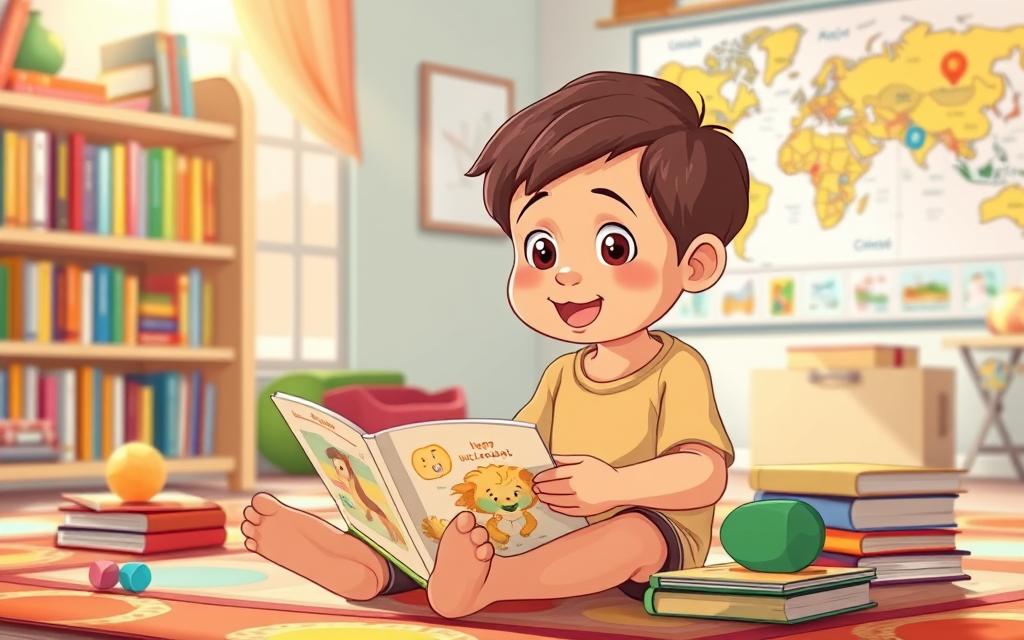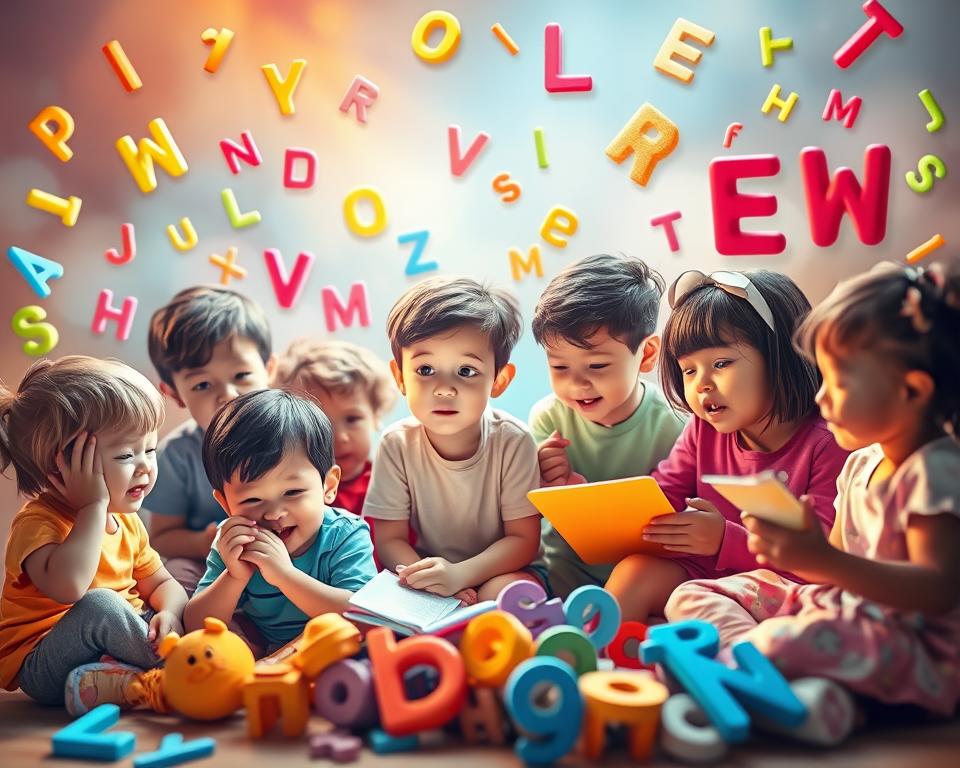Did you know bilingual education boosts young children’s thinking skills? It helps with problem-solving, creativity, and multitasking. As a parent, you can boost your child’s language skills for a global world through bilingual child development.
This method improves your child’s thinking, social, and emotional growth. It makes them more competitive in jobs and better at handling different cultures.
Starting bilingual education early gives your child a big advantage. It improves school grades, boosts confidence, and teaches cultural awareness. Today, 75% of employers see bilingualism as a big plus, especially in global markets.
Remember, bilingual child development is a smart investment in your child’s future. It lays a strong base for language, social, and emotional growth, and opens doors for education and careers.
Through bilingual child development, your child gets a solid start in language. This is key in a world where speaking multiple languages is more important than ever. Bilingualism equips your child with skills for success in diverse and global environments.
Exploring bilingual child development opens up many ways to empower your child’s language skills. It prepares them for a bright and successful future.
Understanding Bilingual Child Development
Thinking about bilingual education for your child? It’s key to grasp bilingual child development. Dual language learning is a complex process. It involves learning two languages, which can greatly boost your child’s thinking skills. Studies reveal bilingual kids often have better problem-solving and memory.
There are two main types of bilingual development: coordinate and compound. Coordinate bilingualism happens when a child learns two languages in different settings. This leads to using each language separately. Compound bilingualism, however, is when a child learns both languages together. This can mix the languages in their mind.
- Bilingual education can start as early as infancy. Research shows kids are most open to learning languages from birth to age three.
- At first, bilingual kids might mix languages or have smaller vocabularies in each language. But this is a normal part of growing up bilingual.
- Studies also show bilingual people are less likely to face cognitive decline or diseases like Alzheimer’s later in life.
By understanding bilingual child development and the perks of dual language learning, you can make smart choices for your child’s education. This way, you equip them with the skills needed to thrive in a world where many languages are spoken.
The Science Behind Language Learning in Young Minds
Language acquisition in young children is one of the most fascinating processes in cognitive science. Unlike adults, who often struggle to learn a new language, children absorb linguistic structures effortlessly during their early years. This phenomenon is rooted in neuroscience, psychology, and developmental biology. Here’s a breakdown of the key scientific principles behind early language learning:
1. The Critical Period Hypothesis
- Proposed by Eric Lenneberg (1967), this theory suggests that there is a biologically determined window (roughly from birth to puberty) during which the brain is highly receptive to language acquisition.
- During this period, neural plasticity is at its peak, allowing children to learn languages with native-like fluency.
- After puberty, language learning becomes more effortful, often resulting in accents and grammatical inconsistencies.
2. Brain Development and Neural Plasticity
- Broca’s Area (responsible for speech production) and Wernicke’s Area (responsible for language comprehension) develop rapidly in early childhood.
- Young brains have more synaptic connections, which are pruned over time—meaning early exposure strengthens language-related neural pathways.
- Studies show that bilingual children have denser gray matter in brain regions linked to executive function, enhancing cognitive flexibility.
3. Statistical Learning and Pattern Recognition
- Infants unconsciously detect statistical patterns in speech, such as syllable frequency and word boundaries (e.g., distinguishing “happy baby” as two words rather than one).
- This ability allows them to deduce grammar rules without explicit instruction.
4. Social Interaction and the “Parentese” Effect
- Contrary to passive exposure (e.g., TV or audio), live interaction is crucial for language learning.
- Parents naturally use “motherese” or infant-directed speech—a high-pitched, slow, exaggerated tone—which helps babies distinguish phonetic sounds.
- Face-to-face communication, gestures (like pointing), and emotional engagement reinforce word-meaning associations.
5. The Role of Babbling and Feedback
- Babbling (e.g., “ba-ba,” “da-da”) is a child’s way of experimenting with sounds and receiving feedback.
- When caregivers respond, neural pathways are reinforced, accelerating vocabulary growth.
6. Bilingualism and Cognitive Benefits
- Children raised bilingual show advantages in executive control, problem-solving, and even delayed onset of dementia in later life.
- Their brains learn to suppress one language while using the other, enhancing mental flexibility.
Young minds are wired for language acquisition due to a combination of neuroplasticity, statistical learning, and social interaction. Understanding these mechanisms can help educators and parents optimize early language exposure—whether for monolingual or multilingual development.
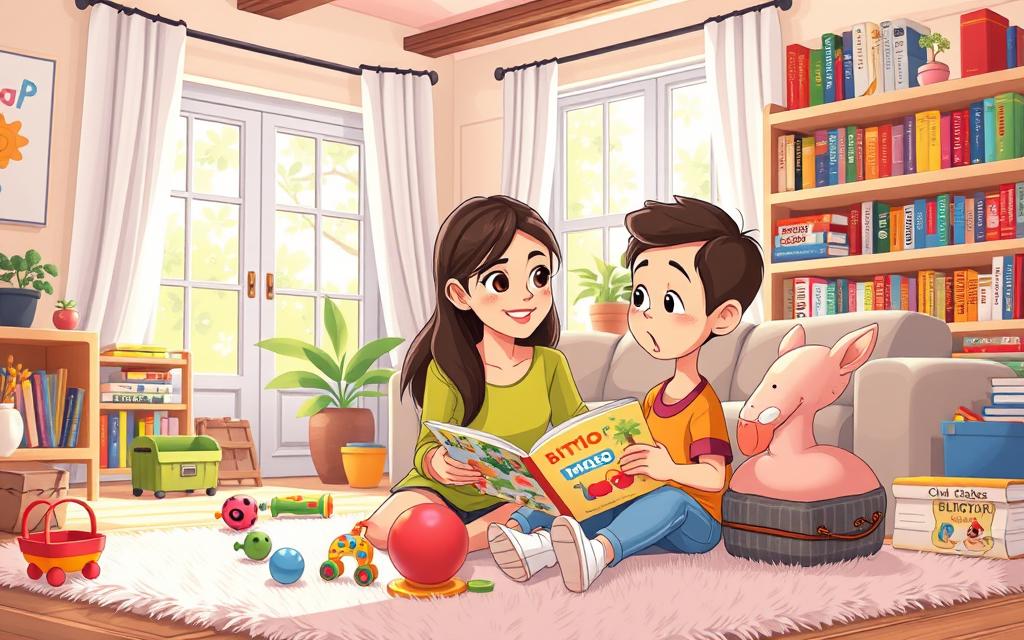
By grasping the science of language learning and using effective strategies, you can support your child’s bilingual growth. This sets them up for success in their language journey.
Remember, language learning is complex, and every child is different. By staying informed and adjusting your approach, you can help your child excel in their bilingual world.
Cognitive Benefits of Raising Bilingual Children
Raising bilingual children can greatly improve their thinking skills. They learn to solve problems better, remember more, and understand different cultures. This helps them do well in school and in life.
Being bilingual boosts executive function. This means they can plan, focus, and handle many tasks at once. They also have improved working memory, which is key for learning and remembering. Plus, bilingual kids may avoid dementia and Alzheimer’s for years, showing bilingualism’s brain-protecting power.
Research in neuroscience and psychology has uncovered numerous advantages linked to bilingualism, extending far beyond linguistic ability. Here’s a breakdown of the key cognitive benefits:
1. Enhanced Executive Function
Bilingual children often outperform monolinguals in tasks requiring executive control—the brain’s ability to plan, focus, and switch between tasks efficiently. This is due to:
- Inhibitory Control: Constantly managing two languages strengthens the ability to suppress irrelevant information (e.g., ignoring one language while speaking the other).
- Cognitive Flexibility: Switching between languages enhances mental adaptability, helping kids solve problems creatively.
- Working Memory: Juggling multiple linguistic systems improves memory retention and processing speed.
Study Support: A landmark study by Bialystok (2004) found that bilingual children were better at ignoring distractions in the Simon Task, a classic test of attention control.
2. Delayed Cognitive Decline & Neuroprotection
Bilingualism doesn’t just benefit childhood—it builds cognitive reserve, delaying dementia and Alzheimer’s by 4–5 years on average (Craik et al., 2010).
- Bilingual adults show higher gray matter density in brain regions linked to memory and decision-making.
- The constant “exercise” of managing two languages may slow age-related brain atrophy.
3. Improved Metalinguistic Awareness
Bilingual children develop a deeper understanding of language structure, including:
- Grammar & Syntax: They recognize that rules are arbitrary (e.g., “Why does Spanish put adjectives after nouns?”).
- Early Literacy: Many bilingual kids learn to read earlier due to heightened phonological awareness (distinguishing sounds).
Example: A child who speaks both English and Mandarin may grasp abstract concepts like “tones” or “verb conjugations” more intuitively.
4. Better Problem-Solving & Creativity
The mental juggling of two languages fosters divergent thinking—the ability to generate multiple solutions to a problem.
- Bilingual kids often score higher on non-verbal IQ tests and creative tasks (e.g., “How many uses can you think of for a paperclip?”).
- They’re more likely to consider multiple perspectives, aiding in conflict resolution.
5. Social & Emotional Advantages
- Empathy & Theory of Mind: Switching languages requires understanding a listener’s background, boosting social sensitivity (Fan et al., 2015).
- Reduced Bias: Exposure to multiple cultures makes bilingual children less prone to racial or linguistic stereotypes.
- Resilience: Navigating two linguistic worlds builds confidence in handling ambiguity and adapting to new environments.
6. Academic Performance
Contrary to myths about “language confusion,” bilingualism correlates with:
- Higher standardized test scores (especially in math and reading).
- Improved focus in noisy classrooms (thanks to better selective attention).
- Easier third-language learning due to enhanced pattern recognition.
Note: The “bilingual advantage” is strongest when both languages are actively used, not just passively heard.
Potential Challenges (and Why They’re Overcome)
- Temporary Mixing: Young kids might blend languages (e.g., “Spanglish”), but this is a normal phase, not confusion.
- Slightly Smaller Vocab: Bilinguals may know fewer words per language initially, but their total vocabulary (across both languages) often surpasses monolinguals’.
How to Maximize Benefits
- Consistent Exposure: Use the “one parent, one language” method or dedicate contexts (e.g., home vs. school).
- Engagement: Encourage storytelling, songs, and games in both languages.
- Avoid Pressure: Natural, playful interaction works better than forced drills.
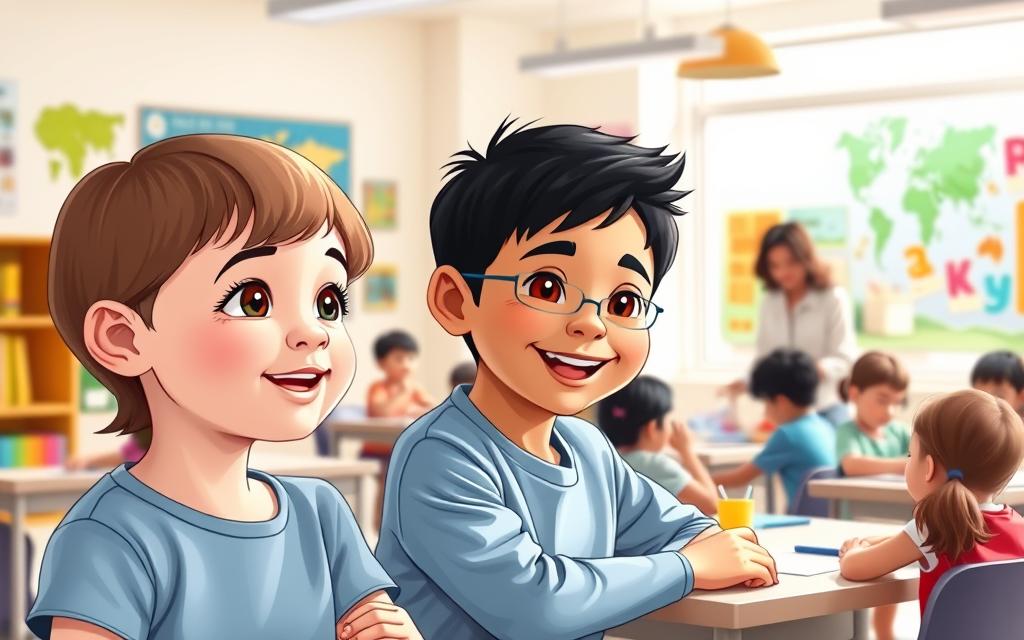
- Improved problem-solving skills and creativity
- Enhanced memory and attention
- Greater cultural awareness and understanding
- Improved academic performance, particularly in math and reading
- Increased cognitive flexibility and adaptability
By using bilingual education, parents give their kids a strong start. They build skills that will help them succeed in many areas of life.
Windows of Opportunity: When to Start Language Learning
As a parent, you might wonder when to start teaching your child a second language. The key is understanding “windows of opportunity” in language learning. Young children can pick up languages faster and easier than older ones. Their brains are ready to learn and process language from a young age.
Research shows that 2-day-old infants recognize and prefer their native language. A lot of language development happens before they turn 2. By 3 or 4, bilingual kids can be as good as monolingual kids if they get enough language exposure. This shows how crucial bilingual education is for young children.
Some important stats to think about:
- Nearly 22 percent of Americans speak a language other than English at home.
- Bilingual children exposed to two languages before seven can speak both like natives.
- Children from bilingual homes in dual-language schools do as well as monolingual kids.
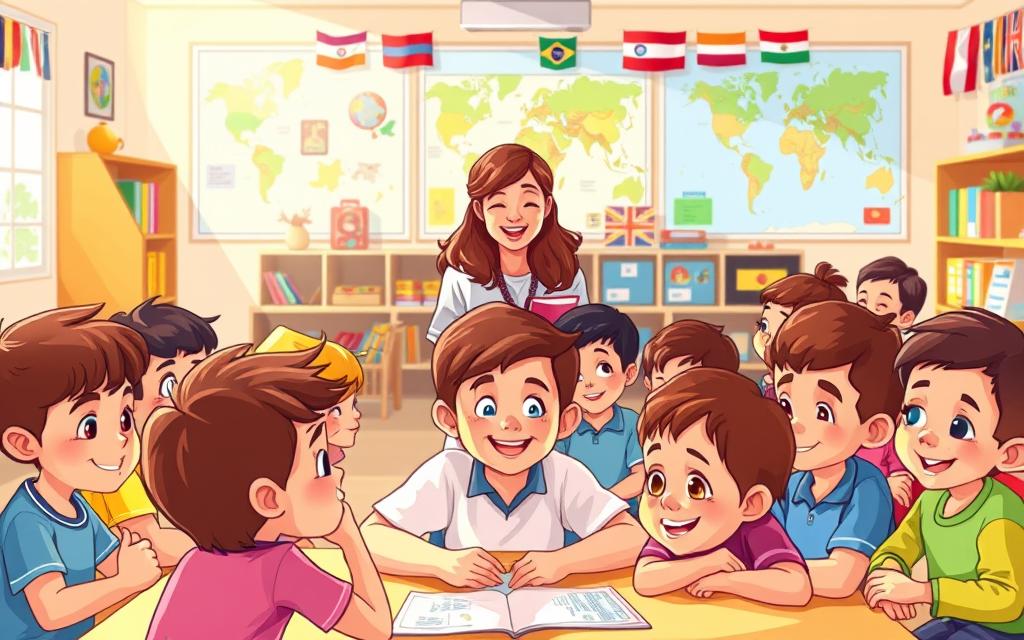
Here’s a science-backed guide to the best times for introducing new languages—and why earlier is often better.
1. The Critical Period Hypothesis: Biological Timelines
Proposed by neurologist Eric Lenneberg (1967), this theory suggests that language acquisition is most effortless during a biologically constrained window, roughly from birth to puberty. After this period, learning a new language requires more conscious effort, and achieving native-like fluency becomes harder.
Key Developmental Phases:
- 0–3 Years: The brain’s plasticity is at its peak. Infants can distinguish all phonetic sounds (even those not in their native language) and absorb grammar implicitly.
- 3–7 Years: Children learn languages without an accent and develop intuitive grammar. Bilingual kids often reach native-level proficiency if exposed consistently.
- 7–Puberty: Fluency is still achievable, but accent and grammatical accuracy may decline. Learning becomes more rule-based (like adult language study).
- Post-Puberty: The brain relies on explicit learning (e.g., memorization), making fluency harder to attain.
Evidence: Studies of international adoptees show that those exposed to a second language before age 7 perform like native speakers, while later learners rarely do (Johnson & Newport, 1989).
2. The “Earlier the Better” Rule for Phonetics
- Birth–12 Months: Babies are “universal linguists” capable of distinguishing sounds in any language (e.g., Japanese infants can hear the difference between “L” and “R,” but lose this ability by 10–12 months if unused).
- 1–5 Years: Children mimic accents perfectly because their auditory processing is fine-tuned to subtle sound variations.
- After Age 7: Pronunciation becomes influenced by the first language’s phonetic patterns, leading to accents.
Practical Implication: Introduce a second language before age 5 for the best chance of accent-free speech.
3. Grammar vs. Vocabulary: Different Learning Curves
- Grammar: Best acquired implicitly before age 7. Young children absorb rules naturally (e.g., verb conjugations) without formal instruction.
- Vocabulary: Can be learned at any age, but contextual exposure (e.g., conversations, stories) is more effective than rote memorization.
Example: A 4-year-old immersed in Spanish will intuitively grasp gendered nouns (“el libro,” “la mesa”), while a teen may need explicit lessons.
4. The Role of Social Interaction
Passive exposure (e.g., videos) is insufficient—live interaction is key during critical periods.
- Infants: Need responsive caregivers using “parentese” (high-pitched, slow speech) to build neural connections.
- Toddlers: Learn through play and repetition (e.g., songs, nursery rhymes).
- School-Age Kids: Benefit from peer interaction (e.g., bilingual schools, playgroups).
Study: MIT researchers (2018) found that children learned vocabulary best through face-to-face conversation, not screens.
5. Can You Miss the Window?
While early childhood is ideal, later learning is still possible—but with differences:
- Adolescents/Adults: Learn faster initially (due to advanced cognition) but rarely achieve native-like fluency.
- Neuroplasticity Boosters: Immersion, consistent practice, and emotional engagement (e.g., friendships in the target language) can enhance later learning.
Exception: Phonetic mastery is hardest post-puberty, but grammar and vocabulary can still reach high levels.
6. Practical Strategies by Age
| Age | Best Approach | Example Activities |
|---|---|---|
| 0–3 | Dual-language immersion at home | Lullabies, labeling objects, baby sign language |
| 3–7 | Play-based learning + formal exposure | Bilingual preschool, cartoons, storytelling |
| 8–12 | Structured lessons + cultural context | Language apps, exchange programs, books |
| Teens+ | Immersion + goal-oriented practice | Study abroad, conversation clubs, media (films/podcasts) |
Start Early, But It’s Never Too Late
- For native-like fluency: Begin before age 7, ideally in infancy.
- For cognitive benefits: Bilingualism at any age improves executive function and memory.
- For older learners: Focus on immersion and meaningful interaction to bypass textbook limitations.
Takeaway: The brain’s language windows are widest in early childhood, but with the right methods, learners of all ages can thrive.
These facts underline the importance of language diversity for all kids. Starting bilingual education early can give your child a head start in a global world. It’s a gift that can open doors to new opportunities.
Create a Supportive Bilingual Environment at Home
As a parent, you are key in shaping your child’s language skills. A supportive bilingual home environment can help your child enjoy bilingualism’s benefits. Studies show that kids learning two languages from birth can speak both like a native by age 5.
Children in bilingual homes can switch languages easily, up to 90% efficiently. This is because they are used to speaking both languages.
To create a bilingual home, try language exposure strategies like OPOL (One Person, One Language). This method can cut language mixing in kids by half. Daily routines for language practice, like an hour of English each day, are also helpful.
Using apps, English materials, and English-only zones in the home can boost language learning.

Effective Strategies for Language Practice
- Engage in bilingual playdates to increase your child’s ability to understand and use the second language by 40%
- Use English-language media, such as stories, music, and videos, to promote bilingualism
- Interact with other English speakers to significantly enhance your child’s language development
By using these strategies, your child can build a strong foundation in both languages. Bilingualism brings many benefits, like better problem-solving and memory. Creating a bilingual home environment takes dedication, but the rewards are worth it.
Common Challenges in Bilingual Development
Raising bilingual children comes with its own set of challenges. One big worry is that the minority language might not keep up, especially in school. This can cause a loss in the home language skills.
Keeping up with using the right language all the time is hard. Life’s ups and downs and kids’ own wishes can make it tough. Also, finding books and media in minority languages is often hard. This affects how well kids can speak their minority language.
Moreover, bilingualism and brain development are closely tied. Not using the minority language enough can hurt how well kids think and learn.
Some common challenges in bilingual development include:
- Language mixing and code-switching
- Setting realistic language proficiency goals
- Managing language use in multilingual families
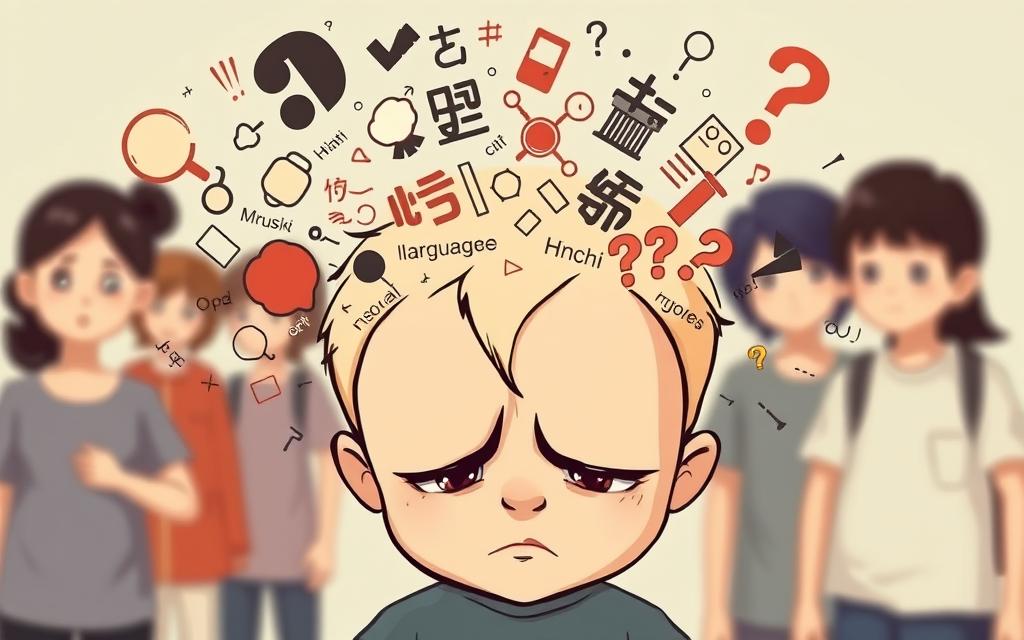
But, research shows bilingual kids can still make friends and feel good about themselves. They can even do well in school. By sticking to using both languages, you help your child grow strong in both.
Educational Approaches for Bilingual Children
As a parent, you want the best for your child’s education. For bilingual kids, this can be a special challenge. It’s key to help them learn languages well for their brain growth and future success. The right way to teach bilingual kids is very important.
There are many ways to teach bilingual children. Some parents choose immersion programs. These programs let kids learn and use their language skills in a fun, real way.
Effective Educational Programs
- Immersion programs: These programs provide an immersive environment where children can learn and practice their language skills in a natural and engaging way.
- Dual language schools: These schools offer a bilingual education, where children can learn and practice both languages in a supportive and structured environment.
- Supplementary language education: This can include language classes, tutoring, or online resources that provide additional language support and practice for bilingual children.
Studies show dual-language schools are great for multilingual kids. But, they often cost more and are for wealthier families. By giving your child access to these programs, you help them learn languages and grow as bilingual kids.
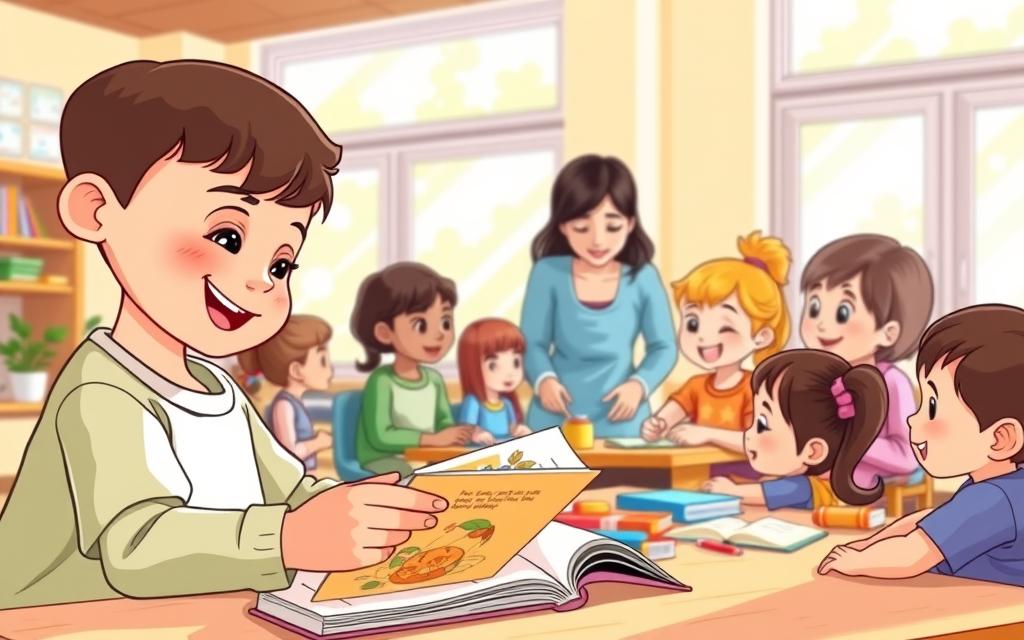
Below are evidence-based approaches tailored to different age groups and learning environments.
1. Key Principles for Bilingual Education
A. Language Exposure Balance
- Dual-Language Immersion: Aim for 30%+ exposure in each language to maintain fluency.
- Contextual Separation: Use clear language boundaries (e.g., one language at home, another at school).
B. Active Engagement Over Passive Learning
- Interactive Communication: Conversations, storytelling, and debates are more effective than TV or apps alone.
- Literacy Development: Reading and writing in both languages strengthens cognitive benefits.
C. Cultural Integration
- Link language learning to cultural experiences (e.g., festivals, food, traditions) to boost motivation.
2. Best Educational Models for Bilingual Kids
| Model | How It Works | Best For |
|---|---|---|
| One Parent, One Language (OPOL) | Each caregiver speaks a different language. | Families with bilingual parents. |
| Minority Language at Home (ML@H) | Parents speak the less dominant language at home (e.g., Spanish), while school uses the majority language (e.g., English). | Immigrant families preserving heritage language. |
| Dual-Language Schools | 50/50 instruction in both languages (e.g., English in the morning, French in the afternoon). | Families in multilingual communities. |
| Time & Place (T&P) | Assign languages to specific times (e.g., Mandarin at dinner) or places (e.g., German in the car). | Families with limited bilingual exposure. |
Note: Consistency is key—frequent switching without structure can delay fluency.
3. Age-Specific Strategies
A. Infants & Toddlers (0–3 Years)
- Narrate Daily Activities (“Now we’re putting on your shoes—¡Vamos a ponerte los zapatos!”).
- Use Songs & Rhymes (Nursery rhymes in both languages reinforce phonetic awareness).
- Baby Sign Language (Bridges communication before speech develops).
B. Preschoolers (3–5 Years)
- Bilingual Storytime (Read alternating books in each language).
- Playgroups with Native Speakers (Encourages natural conversation).
- Labeling Household Items (Use sticky notes in both languages).
C. School-Age Children (6–12 Years)
- Dual-Language Schooling (Best for balanced literacy).
- Language Apps with Supervision (Duolingo Kids, Gus on the Go).
- Pen Pals or Video Calls with relatives/peers who speak the target language.
D. Teenagers (13+ Years)
- Media Consumption (Movies, YouTube, podcasts in the target language).
- Debates & Journaling (Encourages advanced vocabulary).
- Exchange Programs (Immersion accelerates fluency).
4. Overcoming Common Challenges
| Challenge | Solution |
|---|---|
| Language Mixing | Gently correct by repeating the sentence properly (Child: “Quiero un apple!” → Parent: “Ah, ¿quieres una manzana?”). |
| Refusal to Speak One Language | Make it fun (games, rewards) and ensure real-life utility (e.g., trips to a country where it’s spoken). |
| Academic Lag in One Language | Supplement with tutoring or targeted reading practice. |
| Limited Community Support | Seek online language communities, cultural clubs, or virtual tutors. |
5. Measuring Progress & Success
- Fluency ≠ Perfection: A child may prefer one language but still understand both.
- Milestones to Track:
- Ages 2–4: Mixing languages is normal; focus on comprehension.
- Ages 5–7: Should form complex sentences in both languages.
- Ages 8+: Should read/write near grade level in the school language.
6. Tech & Resources for Bilingual Education
- Apps: Duolingo Kids, Gus on the Go, Little Pim.
- Books:
- The Bilingual Edge (King & Mackey) – Parent guide.
- Max’s Words (Kate Banks) – Children’s book on language curiosity.
- YouTube Channels:
- Super Simple Español (for Spanish learners).
- Basho & Friends (fun language songs).
Choosing the right education for your bilingual child helps them learn languages and understand different cultures. Remember, teaching your child to speak multiple languages is a long-term effort. It needs patience, commitment, and the right support.
Technology and Resources for Language Learning
Exploring the world of language learning, you’ll discover many digital tools and resources. These can make learning languages fun and engaging for your child. With educational apps, online programs, and digital platforms, you can create a rich language learning environment.
Finding the right resources is key for your child’s language needs. Language learning apps like Duolingo offer lessons in over 30 languages. Online platforms like Digital Dialects provide learning materials for 80 foreign languages, including rare ones.
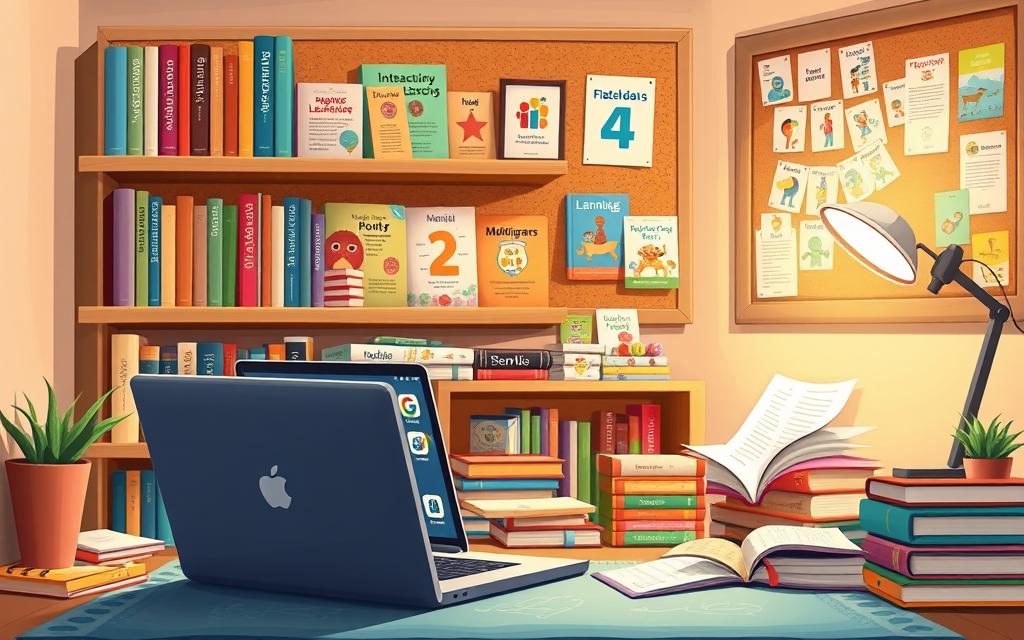
For a deeper experience, online language communities are great. Here, your child can talk with native speakers and improve their skills. Some top resources include:
- MUZZY, an online program or app that uses natural immersion for learning
- Mondly Kids, with gamified lessons for 33 languages
- Droplets, offering short lessons and games for over 37 languages
Using these digital tools and resources can help your child love learning languages. It’s important to try different options to find what works best for your child.
Measure Your Child’s Progress
As a parent, you want to see how your child is doing in learning two languages. Bilingual kids often do better in school because they learn more. They get better at math, reading, writing, and science.
Here are some things to look at when checking your child’s progress:
- Language skills: See how well they speak and understand both languages.
- School grades: Check their grades in different subjects. Bilingual kids might do better.
- Thinking skills: Watch how they solve problems and remember things. Learning two languages helps with these skills.
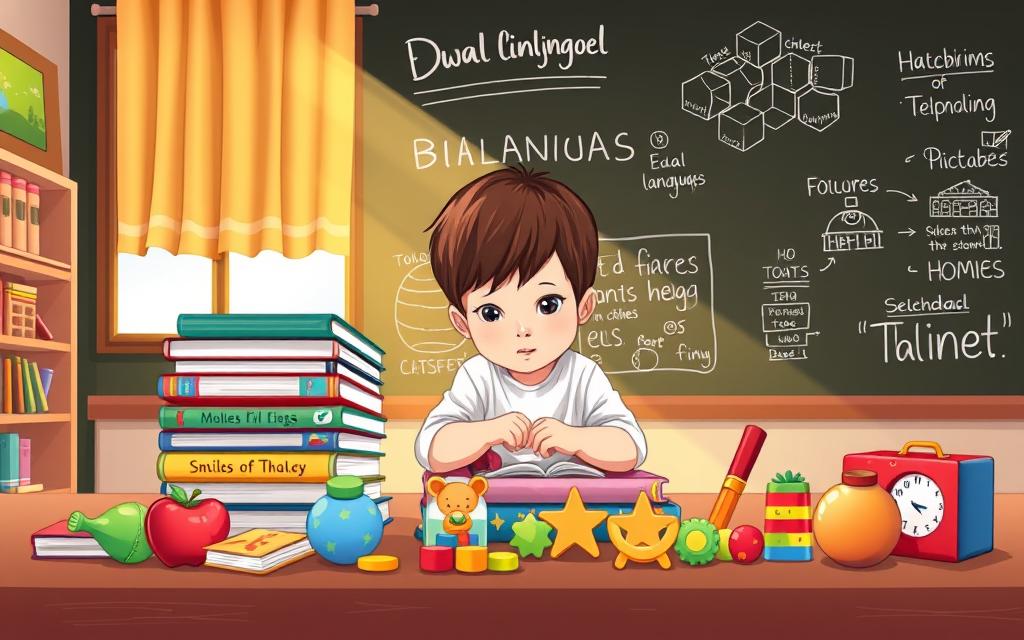
Keep an eye on your child’s progress and support their language learning. This will help them do well in school for a long time. Stay up to date with new research on bilingual education to help your child the most.
Build Cultural Connections Through Language
As your bilingual child explores the world, their language skills open doors to many cultures. By encouraging a love for international media and literature, you help them appreciate global diversity. Look for cultural activities and events that celebrate their home languages and introduce new experiences.
Encourage your child to watch international films, read books, and listen to music in their native languages. This boosts their language skills and widens their view of the world. Find local groups, cultural centers, or language meetups for your family to connect with others who share your background.
Your child’s bilingual journey is about more than speaking two languages. It’s about gaining a global perspective, empathy, and a lifelong love for diversity. By building these connections, you prepare your child for a world that’s more connected than ever.
Additional Resources:
1. General Bilingualism & Cognitive Benefits
- “The Amazing Benefits of Being Bilingual” – BrainFacts.org
- Link | Covers cognitive advantages like executive function and delayed dementia.
- “How the Brain Benefits from Being Bilingual” – Scientific American
- Link | Explores neuroplasticity and mental flexibility.
- “Raising Bilingual Children: Separating Fact from Fiction” – Multilingual Living
- Link | Debunks myths (e.g., “language confusion”).
2. Language Learning Strategies by Age
- “How to Raise a Bilingual Baby: 0-3 Years” – Bilingual Kidspot
- Link | Practical tips for infants and toddlers.
- “Best Methods to Teach Preschoolers a Second Language” – The Everyday Language Learner
- Link | Play-based learning ideas.
- “Bilingual Education for School-Age Kids: What Works?” – Colorín Colorado
- Link | Compares immersion vs. dual-language programs.
3. Overcoming Challenges
- “When Bilingual Kids Refuse to Speak Your Language” – Bilingual Monkeys
- Link | Solutions for language resistance.
- “Code-Switching: Is Mixing Languages Bad for Bilingual Kids?” – Linguistics Girl
- Link | Explains why mixing is normal.
4. Academic & Literacy Development
- “How Bilingualism Boosts Early Literacy Skills” – Reading Rockets
- Link | Links bilingualism to reading readiness.
- “Raising Biliterate Kids: Teaching Reading in Two Languages” – Literacy Now
- Link | Strategies for balanced literacy.
5. Tech & Tools
- “Best Apps for Raising Bilingual Children” – PandaTree
- Link | Reviews kid-friendly language apps.
- “Using YouTube to Support Bilingual Learning” – Bilingual Avenue
- Link | Curates educational channels.
6. Cultural & Social Aspects
- “How to Keep Heritage Languages Alive” – NAEYC
- Link | Tips for immigrant families.
- “Bilingualism and Social-Emotional Development” – Psychology Today
- Link | Discusses empathy and identity.
7. Success Stories & Expert Insights
- “How We Raised Trilingual Kids (And You Can Too!)” – Multilingual Parenting
- Link | Real-family case studies.

